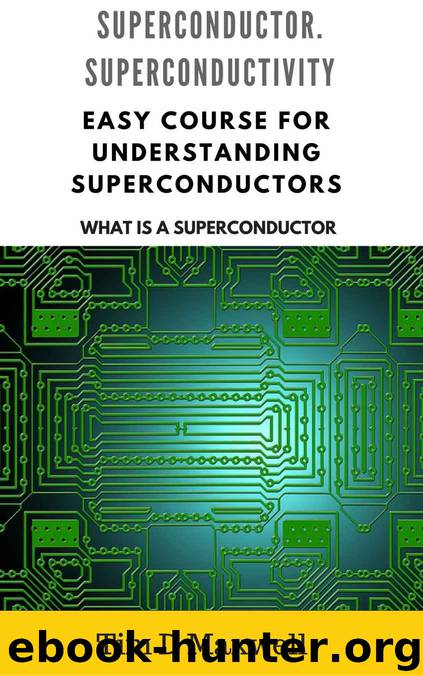Superconductors. Superconductivity : Easy course for understanding superconductors (What is a superconductor) by Tim D Maxwell

Author:Tim D Maxwell [Maxwell, Tim D]
Language: eng
Format: azw3
Published: 2017-06-07T04:00:00+00:00
in this case will take place unlimited increase (or decrease, if V < 0) Josephson phase n and, hence, the periodic variation in time of the overcurrent I s . Thus, when passing through the Josephson element DC | D>> I c , this current is carried by two components of the current I s and I n , which, according to (3) oscillate (in the pro-tivofaze) in time with a frequency proportional to the DC component V voltage drop across the Josephson junction:
The voltage across the Josephson element of V (t) = I n (t) R n will also oscillate in time at a frequency w and this process is called Josephson generation. This state of the Josephson junction is called resistive. It should be emphasized that despite the presence of the voltage drop across a Josephson junction, superconductivity electrodes forming a Josephson element is stored in the resistive state.
If Josephson element has appreciable self-capacitance C (e.g., tunneling Josephson junction), the resistive state of current therethrough will be the sum of three components: I s , I nand a capacitive component of the current (bias current)
Download
This site does not store any files on its server. We only index and link to content provided by other sites. Please contact the content providers to delete copyright contents if any and email us, we'll remove relevant links or contents immediately.
The Complete Stick Figure Physics Tutorials by Allen Sarah(7134)
Secrets of Antigravity Propulsion: Tesla, UFOs, and Classified Aerospace Technology by Ph.D. Paul A. Laviolette(4972)
Thing Explainer by Randall Munroe(3782)
The River of Consciousness by Oliver Sacks(3409)
The Order of Time by Carlo Rovelli(3071)
How To by Randall Munroe(2911)
I Live in the Future & Here's How It Works by Nick Bilton(2837)
A Brief History of Time by Stephen Hawking(2817)
What If?: Serious Scientific Answers to Absurd Hypothetical Questions by Randall Munroe(2542)
The Great Unknown by Marcus du Sautoy(2532)
Midnight in Chernobyl by Adam Higginbotham(2380)
Blockchain: Ultimate Step By Step Guide To Understanding Blockchain Technology, Bitcoin Creation, and the future of Money (Novice to Expert) by Keizer Söze(2377)
Networks: An Introduction by Newman Mark(2264)
The Meaning of it All by Richard Feynman(2213)
Easy Electronics by Charles Platt(2204)
The Tao of Physics by Fritjof Capra(2162)
Midnight in Chernobyl: The Untold Story of the World's Greatest Nuclear Disaster by Adam Higginbotham(2070)
When by Daniel H Pink(2019)
Introducing Relativity by Bruce Bassett(2015)
